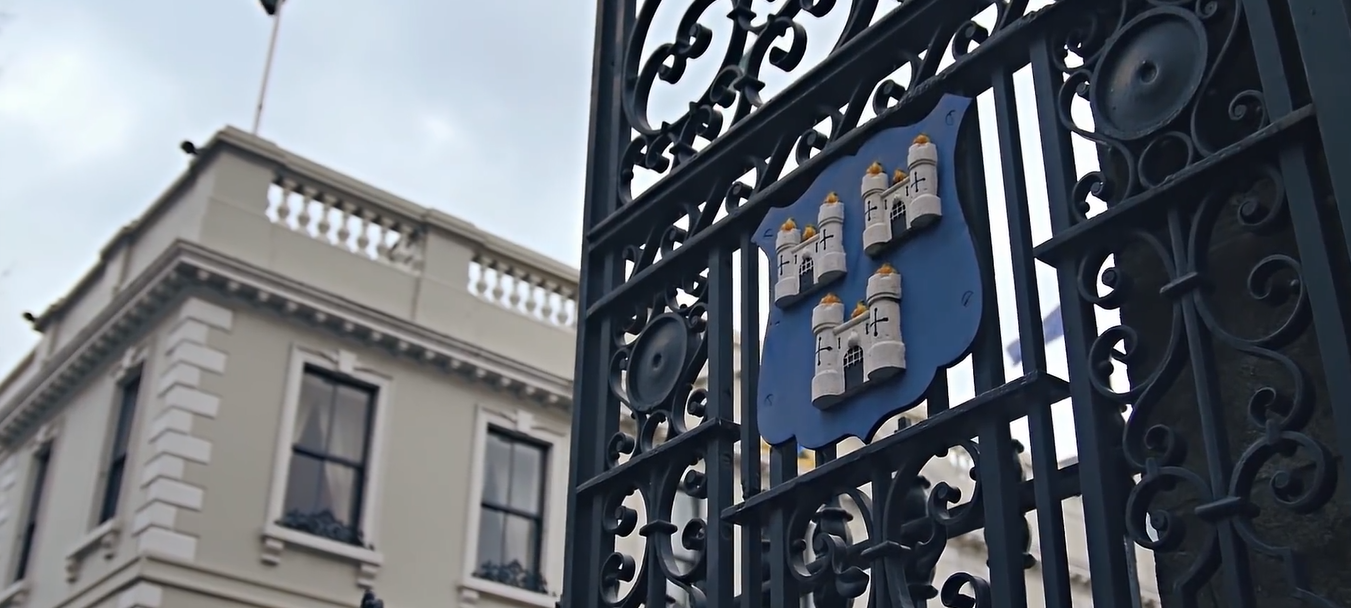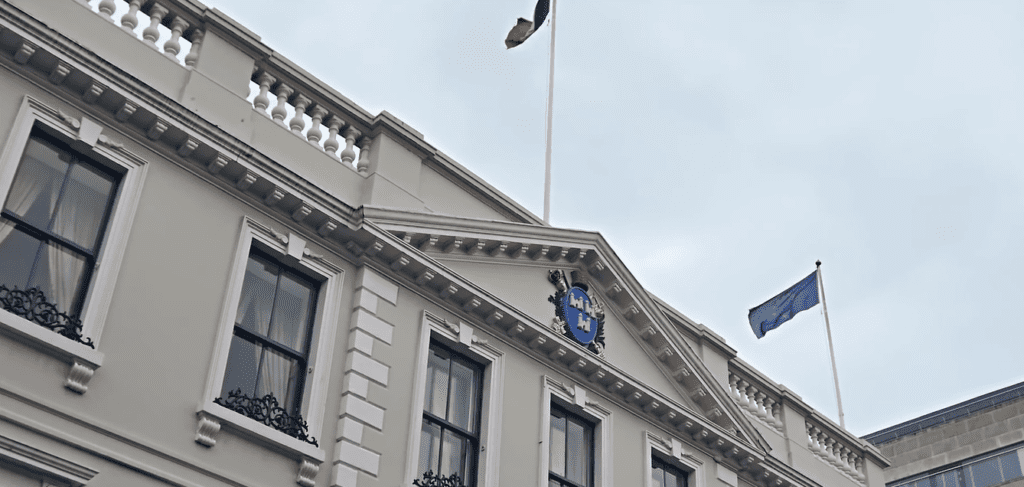Mansion House Dublin, Ireland

Updated On: April 22, 2024 by Ciaran Connolly
Nestled gracefully amidst the vibrant streets of Dublin, Ireland, Mansion House emerges as an emblem of timeless elegance and historical significance. Steeped in centuries of tradition and adorned with exquisite Georgian architecture, this iconic landmark stands as a testament to the city’s rich heritage and enduring legacy. From its regal facade to its illustrious role in shaping Irish politics, Mansion House beckons visitors on a journey through time, inviting them to discover the captivating stories and grandeur that have defined Dublin’s cultural landscape for generations.
With its origins tracing back to the early 18th century, Mansion House has witnessed the evolution of Dublin from a bustling trading hub to a thriving capital city. Designed by the esteemed architect Joshua Dawson and completed in 1710, it quickly became a symbol of civic pride, reflecting the prosperity and ambition of the era. Over the centuries, it has stood as a silent witness to the city’s triumphs and tribulations, its walls echoing with the voices of statesmen, dignitaries, and visionaries who have shaped the course of Irish history.
But Mansion House is more than just an architectural marvel; it is a living testament to the resilience and spirit of the Irish people. It has served as a beacon of hope and unity throughout its history, providing a venue for meaningful gatherings, historic speeches, and groundbreaking decisions. From the inaugural meeting of Dáil Éireann in 1919 to the countless diplomatic receptions and cultural events hosted within its walls, Mansion House has played a pivotal role in shaping the nation’s destiny.
Today, as the official residence of the Lord Mayor of Dublin, Mansion House continues to serve as a symbol of democratic governance and civic pride. Its doors are open to all who seek to explore its rich heritage and cultural significance, offering a glimpse into the soul of Dublin and the spirit of Ireland. Whether marvelling at its architectural splendour, delving into its political history, or simply basking in its timeless charm, visitors to Mansion House are sure to be enchanted by the magic of this iconic landmark.
A Historic Landmark
Mansion House, located on Dawson Street, is one of Dublin’s most iconic buildings. It is a prime example of Georgian architecture, a style synonymous with Dublin’s architectural heritage. Built between 1710 and 1715 by merchant and property developer Joshua Dawson, the house was initially intended as his private residence. However, it later gained fame as the official residence of the Lord Mayor of Dublin.
The design of Mansion House is attributed to renowned architect Nathaniel Clements, who was responsible for many notable buildings in Dublin during the Georgian era. The house’s exterior features elegant red brickwork, symmetrical proportions, and classical detailing, reflecting the architectural tastes of the period.
A Hub of Civic Life
Throughout its long history, Mansion House has been a hub of civic and social activity in Dublin. The house has witnessed countless vital events, from political gatherings to cultural celebrations. One of its most significant roles is as the venue for the inauguration of each new Lord Mayor of Dublin.
The Round Room, an impressive circular hall within Mansion House, has hosted numerous historic meetings and events. The inaugural inaugural meeting of Dáil Éireann, the revolutionary Irish parliament, occurred in 1919. This event marked a pivotal moment in Ireland’s struggle for independence from British rule and solidified Mansion House’s place in the annals of Irish history.
Preserving Tradition
Mansion House has been meticulously preserved despite its age, allowing visitors to revisit and experience the grandeur of Dublin’s past. The interior features opulent reception rooms adorned with intricate plasterwork, sumptuous furnishings, and priceless works of art. These rooms provide a glimpse into the lavish lifestyle enjoyed by Dublin’s elite during the Georgian era.
One of the highlights of any visit to Mansion House is the Lord Mayor’s Drawing Room, where guests can admire exquisite chandeliers, ornate fireplaces, and intricately decorated ceilings. The room is often used for official functions and receptions hosted by the Lord Mayor, adding to its sense of prestige and importance.
Cultural Significance of Mansion House
Beyond its architectural and historical significance, Mansion House plays a vital role in Dublin’s cultural landscape. The house regularly hosts art exhibitions, concerts, and other cultural events, showcasing the talents of local artists and performers. These events contribute to the vibrant cultural scene of Dublin and attract visitors from near and far.
Additionally, Mansion House is open to the public for guided tours, allowing visitors to explore its rich history and learn about its role in shaping the destiny of Dublin and Ireland as a whole. Knowledgeable guides lead visitors through the house’s various rooms, offering insights into its architecture, artwork, and historical significance.
Looking to the Future

As Dublin continues to evolve and grow, Mansion House remains a steadfast symbol of the city’s heritage and identity. Despite the passage of time, the house continues to serve as a focal point for civic engagement and cultural expression, bridging the gap between Dublin’s past and present.
In recent years, efforts have been made to enhance and preserve Mansion House for future generations. For years, restoration projects have been undertaken to ensure the building remains structurally sound and aesthetically stunning. These efforts reflect a commitment to preserving Dublin’s architectural heritage and honouring the legacy of Mansion House.
Exploring Dublin’s Cultural Enclave
Dublin, a city steeped in history and culture, offers an array of attractions near Mansion House that complement its rich heritage. Nestled in the city centre’s heart, Mansion House is a gateway to some of Dublin’s most iconic landmarks and hidden gems. From historic sites to vibrant cultural venues, there’s no shortage of things to see and do near Mansion House. Let’s explore some of the top attractions that await visitors in this cultural enclave.
1. Trinity College Dublin: Just a short stroll from Mansion House, Trinity College Dublin is Ireland’s oldest university and a bastion of academic excellence. Founded in 1592, the university boasts a stunning campus adorned with architectural treasures such as the iconic Campanile and the historic Parliament Square. Visitors can explore the university’s impressive Long Room Library, home to the famous Book of Kells, a beautifully illuminated manuscript dating back to the ninth century.
2. Dublin Castle: Steeped in centuries of history, Dublin Castle is a must-visit attraction within walking distance of Mansion House. Initially built in the 13th century, the castle served as the seat of British rule in Ireland for over seven centuries. Today, visitors can explore its opulent State Apartments, stroll through its meticulously manicured gardens, and delve into its fascinating history through guided tours and exhibitions.
3. National Museum of Ireland – Archaeology: Situated near Kildare Street, the National Museum of Ireland – Archaeology is a treasure trove of Ireland’s ancient past. The museum’s extensive collection includes artefacts from prehistoric times, including the world-renowned Ardagh Chalice and the Tara Brooch. Visitors can immerse themselves in Ireland’s rich archaeological heritage and gain insight into the island’s ancient civilizations through interactive exhibits and informative displays.
4. Grafton Street: For those searching for retail therapy, Grafton Street offers a bustling shopping experience just minutes away from Mansion House. Lined with an eclectic mix of shops, boutiques, and cafes, this pedestrianized thoroughfare is a shopper’s paradise. Visitors can browse everything from high-end fashion brands to quirky souvenir shops while soaking in the lively atmosphere of Dublin’s premier shopping district.
5. St. Stephen’s Green: Escape the hustle and bustle of the city and unwind in the tranquil surroundings of St. Stephen’s Green, a picturesque park adjacent to Grafton Street. Designed in the 19th century, the park features winding pathways, manicured lawns, and serene water features, providing a peaceful oasis in the heart of Dublin. Visitors can enjoy strolls, picnics, and swan-watching in this verdant urban retreat.
6. National Gallery of Ireland: Art enthusiasts won’t want to miss the National Gallery of Ireland, located just a short distance from Mansion House on Merrion Square. Home to an extensive collection of Irish and European art from the Middle Ages to the present day, the gallery offers a diverse range of masterpieces, including works by renowned artists such as Caravaggio, Rembrandt, and Jack B. Yeats. Admission is free, making it accessible to all visitors.
7. Temple Bar: No visit to Dublin would be complete without experiencing the vibrant atmosphere of Temple Bar, the city’s cultural quarter. Situated on the south bank of the River Liffey, Temple Bar is renowned for its lively pubs, eclectic street performers, and thriving arts scene. Visitors can explore its cobbled streets, browse art galleries and craft shops, and sample traditional Irish cuisine in one of its many restaurants and bars.
When to Experience the Magic of Ireland
The best time to visit Ireland depends on personal preferences and interests, as the Emerald Isle offers unique experiences year-round. However, many travellers find that May through September are particularly appealing. During this period, Ireland enjoys longer daylight hours, milder temperatures, and blooming landscapes, making it ideal for outdoor activities such as hiking, cycling, and exploring the lush countryside.
Additionally, this time of year coincides with numerous festivals and events, including traditional music festivals, literary gatherings, and cultural celebrations, providing visitors ample opportunities to immerse themselves in Irish culture. While summer tends to be the busiest tourist activity, shoulder seasons like late spring and early autumn offer a balance of favourable weather and fewer crowds, making them an excellent choice for those seeking a more tranquil experience. Ultimately, the best time to visit Ireland depends on individual preferences, whether chasing the elusive summer sun or experiencing the enchanting beauty of Ireland’s changing seasons.
Conclusion
Mansion House is a testament to Dublin’s rich history and architectural splendour. From its origins as a private residence to its current role as the official residence of the Lord Mayor, the house has played a central role in the city’s life for over three centuries. Its elegant Georgian façade, opulent interiors, and storied past make it a must-visit destination for anyone interested in exploring Dublin’s cultural and historical heritage. As Mansion House continues to enchant visitors with its timeless beauty and historical significance, it remains an enduring symbol of Dublin’s enduring spirit.






